 |
| |
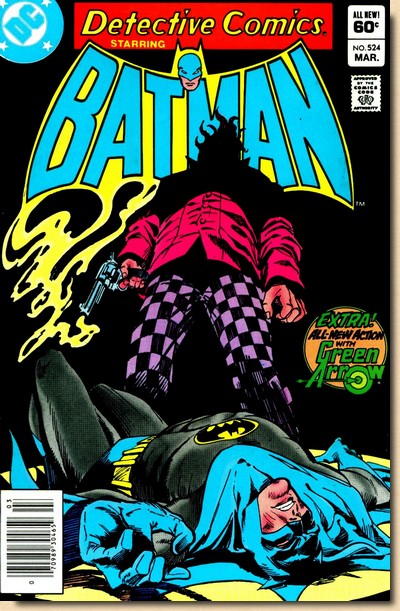 |
|
ENTER THE
CROC
EXIT THE SQUID
DETECTIVE
COMICS #524
(MARCH 1983)
"DEATHGRIP"
(Part 2 of 6)
(17 pages)
Cover
pencils - Ed Hannigan
Cover inks - Dick Giordano
Story - Gerry
Conway
Art - Don
Newton
Inks - Dick Giordano
Colours - Adrienne
Roy
Lettering - Tod Klein
Editor - Len Wein
Second
feature - Green Arrow, "Mob Rule!
(pt 2)" (7 pages)
Letters page - "Batcave" (1
page)
|
|
|
| |
WHAT HAPPENED BEFORE...
... in Batman
#357
Following the downfall
of crime boss Rupert Thorne and the imminent imprisonment
of mob leader Tony Falco, Gotham's underworld falls into
a power vacuum.
|
| |
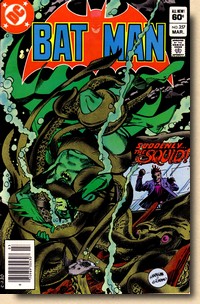 |
|
Soon, a vicious
gang of henchmen terrorizes the now
leaderless second tier mobsters, and
Batman learns that the mystery person
making these moves to take over Gotham's
underworld calls himself "The
Squid" - a name that rings all too
many bells with the Darknight Detective
as he knows from an encounter a few
months ago (in Detective Comics
#497) just who The Squid is. Once
a top spy, Clement Carp used to call
himself The Squid even then, but now he
seems bent on becoming Gotham's new crime
lord and master criminal.
He sets up a
hideout in an old warehouse by the piers
and soon recruits the equally mysterious
Killer Croc to work a protection racket
for him at the visiting Sloan Circus.
Amongst his
arsenal of terror the Squid also counts a
giant octopus which he keeps in a huge
aquarium in his hideout - and commonly
feeds his rivals to it as a demonstration
of his ruthlessness and determination to
take over Gotham's organized crime.
|
|
|
| |
| Pushing further to gain
control of Gotham's underworld, the Squid and his gang
succeed in capturing Batman who is soon plunged into the
huge tank of water holding the giant octopus... |
| |
| Ending
in a classic cliffhanger, the final panel
of Batman #357 tells readers
that all will be continued - in Detective
Comics #524. As a side remark,
Len Wein goofes with his editorial
pointer as he wrongly refers readers to Detective
Comics #499 (rather than #497) for
the Squid's first appearance and previous
encounter with Batman.
PLOT
SUMMARY
Batman is
able to just escape from the tank with
his life, and witnessing this feat has
Killer Croc preparing to leave the party
in a rush as he tells the Squid that he
thinks they are all losers. Enraged by
these remarks, the Squid grabs Croc - a
movement which knocks off his hat and
reveals red eyes and reptilian green
flesh...
|
|
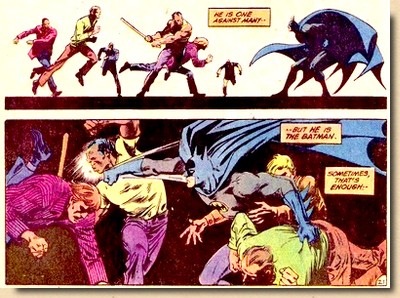 
|
|
|
| |
| With the Squid and his gang
members in shock, Batman seizes this unexpected window of
opportunity and makes his retreat through the shadows of
the warehouse. Croc leaves the Squid after violently
threatening him and returns later that evening to kill
the Squid with a shot from a high-powered rifle... (to be continued
in Batman #358) |
| |
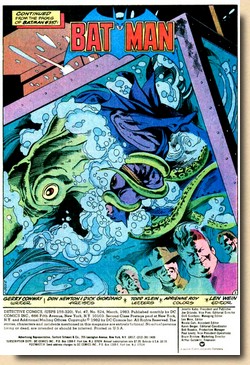 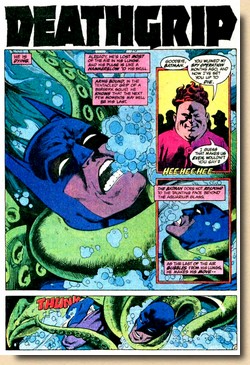 |
|
REVIEW
& ANALYSIS
The
Killer Croc story arc (which would be
Gerry Conway's final work on both Detective
Comics and Batman) builds
up as the physical disfiguration of Croc
and the resulting reptile features are
revealed.
The
limited role the Squid plays in all of
this is made evident by his demise after
a two issue presence, and the threat
level is not only passed on to Croc but
also raised - a fact easily underscored
by the psychology of names and apperances
as a crocodile will always seem to be
more menacing and lethal than a squid...
It
would seem fairly easy to ridicule
Clement Carp and the name he has chosen
for himself, not the least because he is
portrayed as a short and fat character
who talks with a speech impediment.
|
|
|
| |
| Indeed, Conway has an
assortment of gang leaders (assembled in the Squid's
hideaway to hear his plan) make remarks precisely in that
direction: nobody with a name like "the Squid"
could seriously become their leader - comments to which
Carp replies that the name fits him not the least because
his "tentacles reach everywhere, even to the
seats of power". Actually, the way Carp's
speech defect is portrayed this should read "my
tentacles weach evewywhewe, even to the seats of
powew", but either editorial wasn't paying
attention or it was judged too much to have each and
every "r" replaced by a "w" as the
Squid does retain quite a lot of rolling "r"s
in the lettering... |
| |
| One
could also add - on a meta level, of
course - that the Squid bears a certain
resemblance to one of the Batman's
classic villains: the Penguin. Whether or not Gerry
Conway and Don Newton had that in mind
when they created the Squid for Detective
Comics #497 (December 1980), who
knows. On the other hand it is quite
evident that the slightly comical and
cartoonish character could not provide a
sustained level of believable threat -
but as such he provided a crescendo
by opening, so to speak, the door for
Killer Croc, and thus catapulting the
story to an entirely different level as,
clearly, there is nothing whatsoever
comical about Killer Croc, and the
quality of viciousness and hence danger
he poses is beyond any doubt, a fact not
the least proven by his cold blooded
shooting of the Squid.
It would
therefore almost seem as though Conway
only sets up and uses the Squid as a plot
device. It will not work for readers who
simply find this villain too cheesy, but
for those who can bear the Squid he plays
his role well, even up to his death which
fuels the plot and storyline.
Don Newton's
pencils are up to his usual high
standards and squeeze the maximum effect
out of this issue which really is still
almost a prologue to far more forceful
events yet to unfold.
|
|
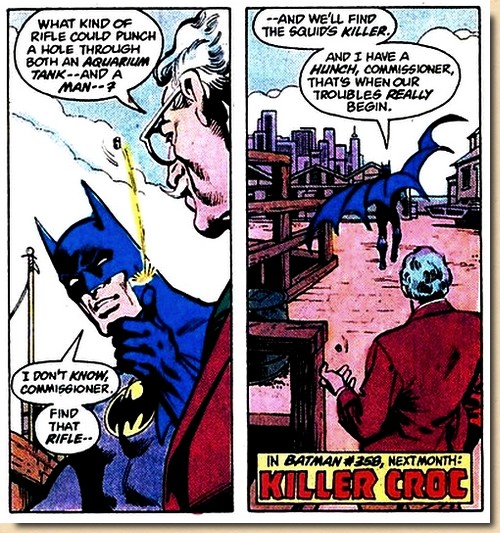
|
|
|
| |
| The visual storytelling is
dynamic, and Newton inserts a number of shots and poses
of the Darknight Detective that have "classic
Batman" written all over them. |
| |
| ENTERTAINING
READING
- Not an issue which will have
anyone wanting to re-read it immediately, yet it
does move along with a well paced storytelling,
and the artwork ranges from dynamic to
captivating. |
|
| |
TRIVIA
The Squid only
appears in three issues of Detective Comics
during his short lifespan as a Batman villain:
#497, 523 and 524, as well as in Batman
#357. He was shot by Killer Croc in Detective
Comics #524, but as is the case so often in
the world of comic books, nothing is as uncertain
as death, and even minor personae such as the
Squid may profit from this golden rule.
However, Carp's
return in the post-crisis continuity of the 52
storyline remained somewhat vague as he was
abducted and forced back into crime by the Intergang's
boss Bruno Mannheim. In the end, the final fate
of the Squid remained uncertain... until he
resurfaced - albeit this time calling himself
Lawrence Loman and with a slightly different
appearance - in Detective Comics Volume 2
#30 (June 2014). He still, however, has his pet
giant squid (still named Gertrude) which he uses
to dispatch his foes and competitors as he is
peddling a new drug with terrible effects (users
burn up from the inside, hence the drug's name
"Icarus") throughout the streets of
Gotham's Chinatown.
|
|
| |
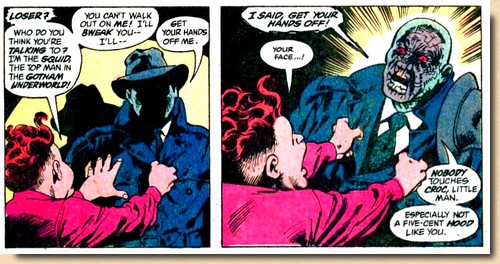
|
|
But the
really bad guy in Detective
Comics #524 is, of course,
Killer Croc. Although readers had
caught a few shadowy glimpses of
this new villain in Batman
#357 (where this six-issues story
arc had kicked off two weeks
previously), the true horrific
nature of Croc was now revealed
in full. Quite unlike
the Squid, Killer Croc would go
on to become a regular Batman
villain, even making it straight
into the movie adaptations.
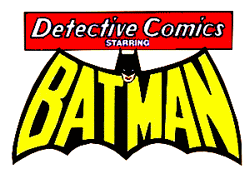
|
|
|
|
| |
| The Batman feature
from Detective
Comics #524 has not
been reprinted since its original
publication, but it was used for several
foreign market editions almost
immediately following its original
publication, namely Batman Superband
#18 (Egmont Ehapa, German edition for
Germany, Switzerland and Austria, 1983), Superserien
#5 (Semic, Norway, 1984) and Stålmannen
#5 (Semic, Sweden, 1984). 
|
|
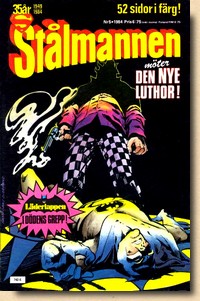 |
|
|
| |












